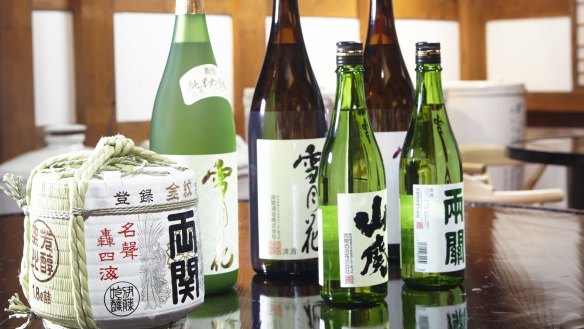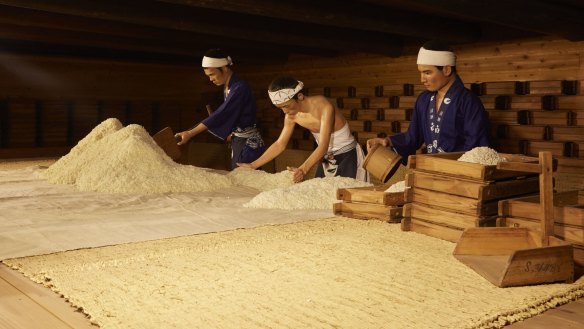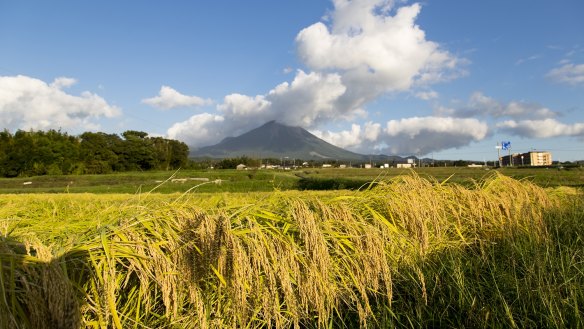The rise and rise of Japanese sake in Australia

Australians are mad for Japan, with a record 550,000 of us visiting in 2018. The tourism boom has created an army of enthusiasts for Japanese food and drink, eager to relive their experiences back home.
Specialist ramen and yakitori joints are on the rise in our major cities, as is consumption of Japanese sake. In fact, Australia is the second fastest growing export market for Japanese sake globally, with total exports in 2018 up 13 per cent to about $5.7 million.
It's an encouraging trend for Leigh Hudson, who in 2013 co-founded Australia's first specialist sake retail outlet, Sake Shop. "We've had huge growth in sake sales over the past two years and it's continued to accelerate," he says.

An alcoholic beverage brewed from rice, sake has more in common with beer than wine or spirits. The other key ingredients are water, yeast and koji mould, which contains enzymes that convert the rice starch to sugar, then into alcohol via fermentation.
Hudson says in the early years of sake retailing, he was battling consumer perceptions of sake that were based on their experiences of extremely poor quality products in Australia. "Now, people are having their first sake experience in Japan, and it's a good experience. They just want to replicate that at home," he says.
Fortunately, achieving an excellent sake and food match is easy, thanks to its low acidity, savoury umami character and the absence of tannins.

"Rarely are you going to get a real train wreck matching food with sake," says sake expert John Gauntner. "However, admittedly sake can be overpowered by a lot of things. Something really spicy, or very sweet or very strong flavoured, will just completely drown out the sake.
"But to me, those are obvious. You can look at a dish and say, 'All right, this spice is just going to completely crush the sake'."
American-born Gauntner is the only non-Japanese certified Master of Sake Tasting in the world. He says drinkers should be feel emboldened to experiment with drinking sake alongside a range of different cuisines, not just Japanese.
"I think that when people overseas want to look into how to pair sake and food, they always say, 'Well, how do they do it in Japan?'," he says. "They're afraid to violate any perceived authenticity. I think that stops people a lot. And the truth is, there really is no authentic way to do it, so violate away!"
Gauntner says Japanese restaurants have never traditionally offered patrons a choice of sakes, as is the European approach with wine service.
"Even today, when you go to a traditional tempura restaurant or a sushi restaurant, for example, they'll have one sake, maybe two," he says.
"They say in Japan that good sake supports good Japanese food. If you look at what makes Japanese food what it is, it's bringing out the natural flavours of the raw materials – they don't use heavy sauces or long, convoluted preparations.
"And that's what sake does a great job of supporting. It underpins or supports the natural flavours of any raw materials that you use."
As for the best way to serve sake in the home, a white wine glass will do a fine job of funnelling aromas.
The traditional service from a flask (tokkuri) into a small thimble-shaped cup (o-choko) is a fun and important part of the sake ritual in Japan, but a wine glass does a much better job of showcasing the liquid.
Traditional sakes are richer and fuller in style because they are made using lesser polished rice (non-Ginjo grade sake). As such they are best suited to serving gently warmed (not hot!). But styles and traditions are changing. Highly polished Ginjo grades are generally lighter and more delicate in style, and typically lend themselves to being served chilled, though some will work either way. Gently warming a sake can showcase its full complexity, bringing different flavour characters to the fore.
Japanese sake festival Sake Matsuri is returning to Melbourne on June 8 and Sydney on October 19. It's the best way to taste a wide range of sakes in the one place and learn from the experts.
In the meantime, here are some distinctive sakes available to buy online, with suggestions on how to enjoy them.
Five to try
Kaze No Mori Akitsuho Junmai 720ml, Nara Prefecture
The character of the rice shines through the fresh, fruit-driven characters of this nama (unpasteurised) sake, sweet in style with a lovely long finish. Store refrigerated to prevent spoilage.
Food match Seafood dumplings.
Available sakeshop.com.au, $38.95.
Senkin Classic Muku Junmai Daiginjo 720ml, Tochigi Prefecture
Showcasing the estate or domaine approach to sake production, Senkin uses rice grown in fields surrounding the brewery and irrigated by the same water source used in the brewing process. A light and delicate, yet complex sake, carrying an array of tropical nutty, earthy and characters with a lovely dry finish.
Food match Fried chicken
Available supersake.com.au (coming soon), $75.
Nagaragawa Junmai 720ml, Gifu Prefecture
A very traditional style sake, mouth-coating and rich with loads of umami flavours, but eminently drinkable. Very enjoyable cold, but serve moderately warm to unlock its full character.
Food match Miso cod.
Available sakeshop.com.au, $29.95.
Kenbishi Kuromatsu 900ml, Hyogo Prefecture
A blend of one to four year-old sakes, fermented using wild yeast. The result is an exceedingly complex and rich sake that is very versatile with food, and lends itself to being served warm.
Food match Washed rind cheese.
Available qantasepiqure.com.au, $69.
Imada Fukucho Junmai Ginjo Biho 720ml, Hiroshima Prefecture
A very modern style, lean and aromatic with vibrant acidity. It's made with Hiroshima's famous soft water, which gives it deep, persistent flavour.
Food match Char-grilled prawns.
Available supersake.com.au, $54.38.
James Atkinson was a guest of the Japanese Sake & Shochu Brewers Association in Japan.